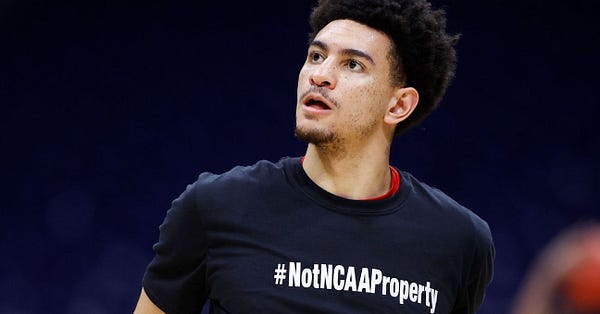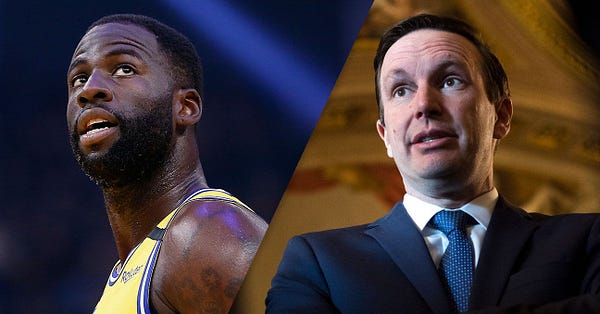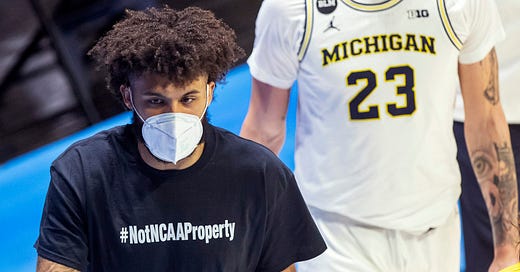The Time is Right for a March Madness Player Strike
History suggests that the athletes behind the #NotNCAAProperty movement won't sit out games. But if they do, this year's basketball tournament presents a unique opportunity for leverage.
Welcome to Hreal Sports, a weekly-ish newsletter written by Patrick Hruby about sports things that don’t stick to sports. Sign up and tell your friends!
Could March Madness be disrupted by an athlete strike? A group of men’s college basketball players protesting the National Collegiate Athletic Association isn’t ruling one out.
Last week, those players—led by Rutgers University’s Geo Baker, the University of Iowa’s Jordan Bohannon, and the University of Michigan’s Isaiah Livers—criticized NCAA rules forbidding athletes from profiting from their names, images, and likenesses (NILs) on Twitter with the hashtag #NotNCAAProperty.
With the support of the National College Players Association, a college athlete advocacy group, the players made four demands:
Changes to NCAA rules by July 1 to allow all college athletes the freedom to secure representation and receive pay for use of their NILs;
A Supreme Court ruling in NCAA v. Alston—a federal antirust case challenging association limits on athlete compensation related to educational expenses—that favors college athletes and does not “not give the NCAA any power to deny us equal freedoms.”
Meetings with state and federal lawmakers regarding laws to ensure physical, academic, and financial protections for college athletes;
A meeting with NCAA President Mark Emmert.


If the players don’t feel like their demands are being acknowledged or met with a sufficient response, Bohannon told Nicole Auerbauch of The Athletic, some sort of work stoppage is possible.
“We can have the talks about using our leverage as players to do something like that,” he said. “Maybe it’s protesting a game or delaying a game—because it would be a nightmare for NCAA. I know they don’t want that … right now, we certainly have the leverage to do that.”
A sit-down during the Sweet Sixteen, Elite Eight, or Final Four would be seismic, a surefire national news story and a direct threat to the broadcast revenue-driven business model of college sports. But history suggests that the odds are against it.
In 2018, players from all Four Final four teams discussed boycotting the open practice held a day before the national semifinals. They couldn’t come to unanimous agreement, and their plan fizzled. In 1995, players from multiple schools talked about blowing up the opening games of the men’s tournament by walking to center court, sitting down on the hardwood, and letting the balls remain idle. They got cold feet. Four years before that, rumor has it, players from the University of Nevada, Las Vegas—the defending national champion, arguably one of the best teams in college hoops history, and a NCAA bete noire—were set to boycott the title game. They lost to Duke University in the semifinals.
There are many reasons why college basketball players—despite their longtime frustration at being economically exploited—have never managed to pull off a postseason strike. Coordinating agreement and action within a single locker room of 18-to-22-year-olds is hard; doing so among two or four or a dozen or more teams is exponentially more difficult. School and fan backlash is a real threat, both in the short and long term—it’s easy to imagine coaches punishing striking athletes, athletic departments pulling their scholarships or otherwise making their lives miserable, and pissed-off alums sabotaging their future networking and career prospects. “You had a lot of pressure,” former University of Massachusetts, Amherst player Rigo Nunez once said about the 1995 strike that wasn’t. "Am I not going to be able to play in the NBA if I do this? Will I be blackballed? All those things weighted heavily on each player."
Moreover, players are competitive. They enjoy playing and winning games, especially in the tournament. They wouldn’t put up with the sheer amount of bullshit doing so requires—like, for instance, hunkering down in an Indianapolis coronavirus bubble—if they weren’t emotionally invested.


Heading into this weekend’s Sweet Sixteen, a work stoppage seems unlikely. Iowa and Rutgers are out of the tournament, which means Baker, Bohannon, and their respective teammates already have left Indianapolis. On the other hand, Livers and Michigan remain in the bubble, and there’s nothing stopping players inside and outside the city from communicating and coordinating. (Hello, Zoom!) Meanwhile, the NCAA hasn’t been particularly responsive to the players’ original list of demands, with Emmert agreeing to meet with Baker and company only after the tournament ends.


Should the players remaining in Indianapolis decide that speaking out isn’t enough, they’ll have one big thing working in their favor: There has never, ever been a more opportune moment to throw sand in the gears of the college sports machine by striking.
Start with money. The NCAA and its member schools need it. Badly. Cancelling last year’s tournament because of the pandemic cost the association more than $800 million in television and ticket revenue, and insurance made up only $270 million of that loss. Meanwhile, athletic departments across the country have lost even more expected revenue during the truncated and attendance-limited recent football and basketball seasons.
The NCAA expects to collect over $800 million from the networks broadcasting this year’s tournament—a cash injection that will go a long way toward salving the financial pain of the last year. By threatening that windfall, athletes could give themselves an enormous amount of immediate leverage. No players, no games. No games, no television inventory to sell ads against. No TV inventory, no broadcast rights payments to the association and its members. No rights payments, no way to pay Emmert’s nearly $3 million annual salary and various college hoops coaches five-and six-figure bonuses for games that were never played. You can see how the dominoes are lined up to fall, here.
Cultural headwinds also are favorable. Players don’t need outside sympathy in order to walk out on their jobs, or to pressure the NCAA to make changes. But it absolutely helps! In the past, stealing money from college athletes largely was seen as good and just. The general public supported amateurism. Journalists earned plaudits and industry awards by doing the association’s policework for it. Federal judges essentially laughed legal challenges to the NCAA textbook restraint of trade out of their courtrooms, while politicians passed laws preventing players from unionizing and making giving money to college athletes an actual crime. When Walter Byers, the man who built the NCAA as we know it, gave a 1995 speech decrying college sports’ "neo-plantation mentality" and calling for players to be paid whatever the market would bear, Sports Illustrated dismissed him as “hysterical.”
Times change. Today, public opinion favors player pay. The media has grown increasingly skeptical of claims that allowing athletes to have basic economic rights will destroy an industry that generates roughly $14 billion a year, and also force Ohio State to drop to Division III. The NCAA’s ongoing failures to protect athletes from COVID-19, concussions, and the likes of Larry Nassar haven’t won it any friends or allies. Nor has its rake-stepping, comically sexist administration of women’s sports in general and the women’s basketball tournament in particular. Slowly but surely, the association has been getting its ass handed to it in antitrust court; next week, the Solicitor General of the United States will argue on the side of athletes in a case currently before the Supreme Court. Meanwhile, lawmakers are introducing and passing bills that will permit players to profit from their NILs, and perhaps enjoy additional rights and protections. The idea that people like Baker are being exploited has become conventional wisdom, as has the notion that NCAA amateurism is structurally racist, transferring large amounts of wealth from predominantly Black laborers to their overwhelmingly White managers and overseers.


The NCAA’s coronavirus bubble itself is another advantage. In a normal year, players would be scattered across multiple cities and time zones—but right now, they’re all in the same place, which makes planning and executing a strike much easier. More importantly, the symbolism of refusing to play while inside the bubble would be uniquely powerful. For decades, the association’s amateurism scam has depended on Americans viewing college athletes as “student-athletes”—students who just happen to play sports and should be grateful for whatever they are given—and not as workers who deserve rights and protections. The bubble, however, has made the truth plain: college athletes are workers, and their labor is essential to the health and well-being of an entire entertainment and school marketing industry. Especially during a plague that has forced those same athletes to put their own health and well-being at risk to keep the money printer humming.


All of the above gives players an awful lot of latent power. Will this be the year they finally exercise it?
Personally, I wouldn’t bet on a March Madness work stoppage—but if one happens, I think it could be much more effective than many people expect. After all, the mere threat of not playing has worked for college athletes before. In 2015, Black football players at the University of Missouri declared on Twitter that they would strike until then-school president Tim Wolfe resigned or was removed from office. Thirty-six hours later, Wolfe was gone.
A few years ago, I spoke about striking with Dave Meggyesy, a former Syracuse University football player who went on to become a National Football League Players Association executive and teach a sports and society class at Stanford University. When Meggyesy was in college, he and his teammates threatened their coach with a postseason sit-down:
Before the 1961 Liberty Bowl, a made-for-television game between Syracuse and the University of Miami, Meggyesy and his teammates held a private meeting. They were worn down from a long season, unenthused about spending their holiday break playing an extra game in frigid Philadelphia. Why are we playing in this game? Who is financially benefitting here? The players had more questions than answers. They also knew that athletes in other bowls, like the Rose and Orange, received complementary wristwatches. And so they delivered an ultimatum to coach Ben Schwartzwalder.
We want watches, they said. Or else we won't play.
"Ben could see we were pissed off and serious," Meggyesy told me. "He was looking at us like, 'Wait a minute, I'm not going to piss off my top players.' He came back a few days later and we got our watches.”
Today’s college athletes, Meggyesy added, are in the same position. Albeit with much higher stakes. My guess? An honest-to-goodness strike could win them much more than watches. “Who's the one percent in NCAA sports?,” Meggyesy said. “And who's the 99 percent? [Athletes] don't realize the power they have. The players are not replaceable. That is what gives them power. Who else is going to play?"
This has been Hreal Sports, a weekly-ish newsletter written by Patrick Hruby about sports things that don’t stick to sports. If you have any questions or feedback, contact me at my website, www.patrickhruby.net. And if you enjoyed this, please sign up and share with your friends.




